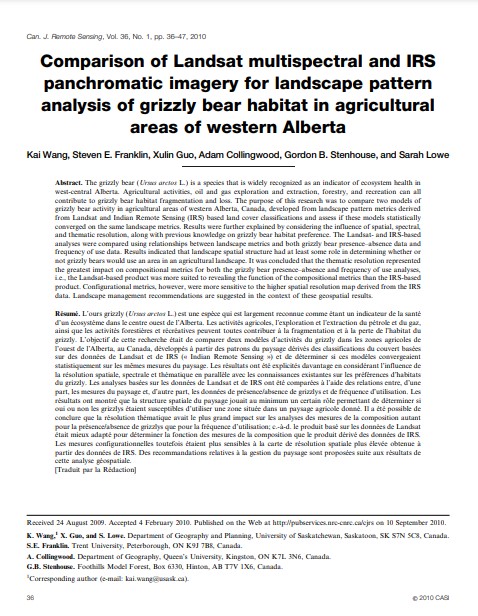Comparison of Landsat multispectral and IRS panchromatic imagery for landscape pattern analysis of grizzly bear habitat in agricultural areas of western Alberta
Bosque Modelo:
Foothills
Temática:
Desarrollo humano
Tipo de documento:
Artículo científico
Resumen
The grizzly bear (Ursus arctos L.) is a species that is widely recognized as an indicator of ecosystem health in west-central Alberta. Agricultural activities, oil and gas exploration and extraction, forestry, and recreation can all contribute to grizzly bear habitat fragmentation and loss. The purpose of this research was to compare two models of grizzly bear activity in agricultural areas of western Alberta, Canada, developed from landscape pattern metrics derived from Landsat and Indian Remote Sensing (IRS) based land cover classifications and assess if these models statistically converged on the same landscape metrics. Results were further explained by considering the influence of spatial, spectral, and thematic resolution, along with previous knowledge on grizzly bear habitat preference. The Landsat- and IRS-based analyses were compared using relationships between landscape metrics and both grizzly bear presence–absence data and frequency of use data. Results indicated that landscape spatial structure had at least some role in determining whether or not grizzly bears would use an area in an agricultural landscape. It was concluded that the thematic resolution represented the greatest impact on compositional metrics for both the grizzly bear presence–absence and frequency of use analyses, i.e., the Landsat-based product was more suited to revealing the function of the compositional metrics than the IRS-based product. Configurational metrics, however, were more sensitive to the higher spatial resolution map derived from the IRS data. Landscape management recommendations are suggested in the context of these geospatial results.
Información Bibliográfica
Autor:
Wang, K., Franklin, S.E., Guo, X., Collingwood, A., Stenhouse, G.B., & Lowe, S.
Revista:
Canadian Journal of Remote Sensing
Año:
2010
N°:
1
País :
Canadá
Páginas:
36 - 47
Volumen:
36
Idioma:
Ingles
Palabras claves
Grizzly Bear, Ursus arctos, home range, movement, habitat





